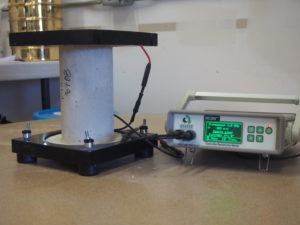Electrical resistivity is an indication of pore connectivity and permeability.

ASTM C1876 (formerly ASTM C1760) measures the electrical resistivity of concrete. Resistivity indicates how difficult it is for a current to get from one end of the sample to another. It’s useful for estimating the diffusion coefficient, as both resistivity and diffusion coefficient result from the pore structure of the concrete.
Samples soak in lime-saturated water to saturate the pores with a known liquid. Measurements can begin immediately after de-molding and can continue over time. The test can measure resistivity on cores as well as cylinders. This test is rapid and repeatable and can be used for quality control and design.
